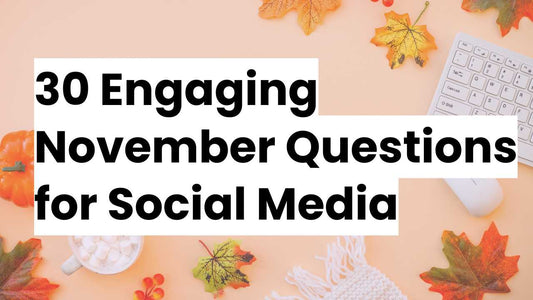Frequently Asked Questions
1. Why is a social media strategy important for businesses?
2. What steps should I take to identify my social media goals?
3. How can I effectively research and understand my audience?
4. What types of content should I create for social media?
5. How can I analyze the success of my social media strategy?
With more competition than ever, knowing how to show up and connect with your audience on the right platforms can make a huge difference in how visible, engaging, and successful your brand becomes.
In this post, we’re breaking it all down and sharing the steps to help you build a strategy that actually works for your goals (and doesn’t leave you overwhelmed in the process).
Understanding the Importance of a Social Media Strategy
Before diving into specifics, it’s crucial to grasp why a well-thought-out social media strategy matters. A solid strategy provides direction and a framework to assess your social media efforts. Here are some key reasons why you need one:
- Targeted Audience Engagement: Knowing your audience allows you to create content that resonates with them, improving engagement rates.
- Brand Consistency: A well-defined strategy ensures consistency in tone, messaging, and visuals across all platforms.
- Measurable Goals: Establishing KPIs helps track your success and allows for adjustments based on performance.
- Resource Optimization: A good strategy helps you manage your time and budget so you can focus on high-impact activities.

Identifying Your Goals and Objectives
The first step in crafting a social media strategy is to define clear goals and objectives. Identify what you want to achieve through social media - whether it’s brand awareness, lead generation, or direct sales. Consider using the SMART criteria: Specific, Measurable, Achievable, Relevant, and Time-bound.
Examples of Common Social Media Goals
- Increase Brand Awareness: Aim to grow your social media followers by a specific percentage within a defined time frame.
- Boost Engagement: Increase the number of likes, shares, and comments on your posts.
- Generate Leads: Utilize social media for lead-capturing tactics like gated content or webinars.
- Drive Website Traffic: Increase traffic to your Shopify store through curated content that links back to your site.
Researching and Understanding Your Audience
Knowing your audience is key to creating content that resonates. Start with the following steps:
1. Define Your Target Demographics
List out the demographic information of your ideal customers, including age, gender, location, income, and interests. Utilize surveys and analytics to collect data on who interacts with your social media channels.
2. Create Audience Personas
Once you have demographic data, create detailed audience personas. These personas should embody the characteristics and preferences of your target customers. The better you understand your audience, the more effectively you can reach them through your content.
3. Monitor Competitors
Analyze your competitors' social media strategies. Look at the type of content they share, their engagement levels, and how often they post. This analysis can provide insight into what resonates with your shared audience.
Creating Engaging Content
Once you’ve established your audience and selected your platforms, the next step is creating engaging content that aligns with your brand's voice and goals. Here are some strategies for crafting compelling content:
1. Leverage User-Generated Content (UGC)
User-generated content increases authenticity and engagement. Encourage your audience to share their experiences with your brand and feature them on your platforms, fostering community and trust.
2. Diversify Content Types
Mixing up content types keeps your audience engaged. Utilize images, videos, polls, quizzes, and stories — gather insights from analytics to see what resonates best.
3. Use Quality Visuals
High-quality visuals make your posts stand out. Whether it’s through stock images, original photography, or graphics, ensure your visuals align with your brand's identity and messaging.
Engaging with Your Audience
Social media is a two-way street. Engaging with your audience helps build relationships and foster loyalty. Here’s how to encourage interaction:
1. Respond to Comments and Messages
Make an effort to promptly respond to comments and direct messages. Showing appreciation for user engagement encourages continued interaction and builds a community around your brand.
2. Host Contests and Giveaways
Contests can generate excitement and engagement. Encourage users to tag friends, share your post, or create content for a chance to win a prize related to your brand.
3. Utilize Polls and Surveys
Polls and surveys not only gather valuable feedback but also engage your audience. Asking for their opinions can foster a sense of involvement and belonging.

Developing a Content Calendar
Planning and scheduling your content in advance ensures consistency and saves time. Develop a content calendar that outlines what to post and when, taking advantage of seasonal trends, holidays, and relevant events. Here’s how to create one:
1. Set Posting Frequency
Determine how often you want to post on each platform. Consider each platform's best practices while maintaining a frequency that works for your team.
2. Plan Content Around Themes
Organize content around specific themes or campaigns. This approach provides consistency and clarity in your messaging while exploring topics thoroughly.
3. Use Tools and Apps
Leverage tools like Socially Suite to schedule posts in advance. These tools can help streamline the process, allowing you to focus on content rather than posting times.

Analyzing Your Results
Evaluation is a critical component of any successful strategy. By analyzing performance metrics regularly, you can refine your approach and drive better results. Here’s how:
1. Identify Key Performance Indicators (KPIs)
Establish KPIs based on your initial goals, such as engagement rates, click-through rates, conversions, and follower growth. This will help ensure you are measuring the right metrics.
2. Use Analytics Tools
Take advantage of analytics tools provided by social media platforms, such as Facebook Insights or Twitter Analytics. Third-party applications can also provide deeper analysis across multiple platforms.
3. Adjust Your Strategy
Use your findings to adjust your content, posting times, or platform focus as necessary. Be proactive in responding to trends and audience preferences.
Building a Loyal Community
Creating an effective social media strategy isn’t just about attracting followers; it’s about building a loyal community. By engaging authentically and consistently, you can turn your followers into brand advocates who actively promote your business. As you implement these strategies, continually assess and adapt your approach based on your results.
Social media is always changing, so agility and adaptability are crucial. Armed with an effective strategy and a commitment to genuinely connecting with your audience, you’re well on your way to social media success.











